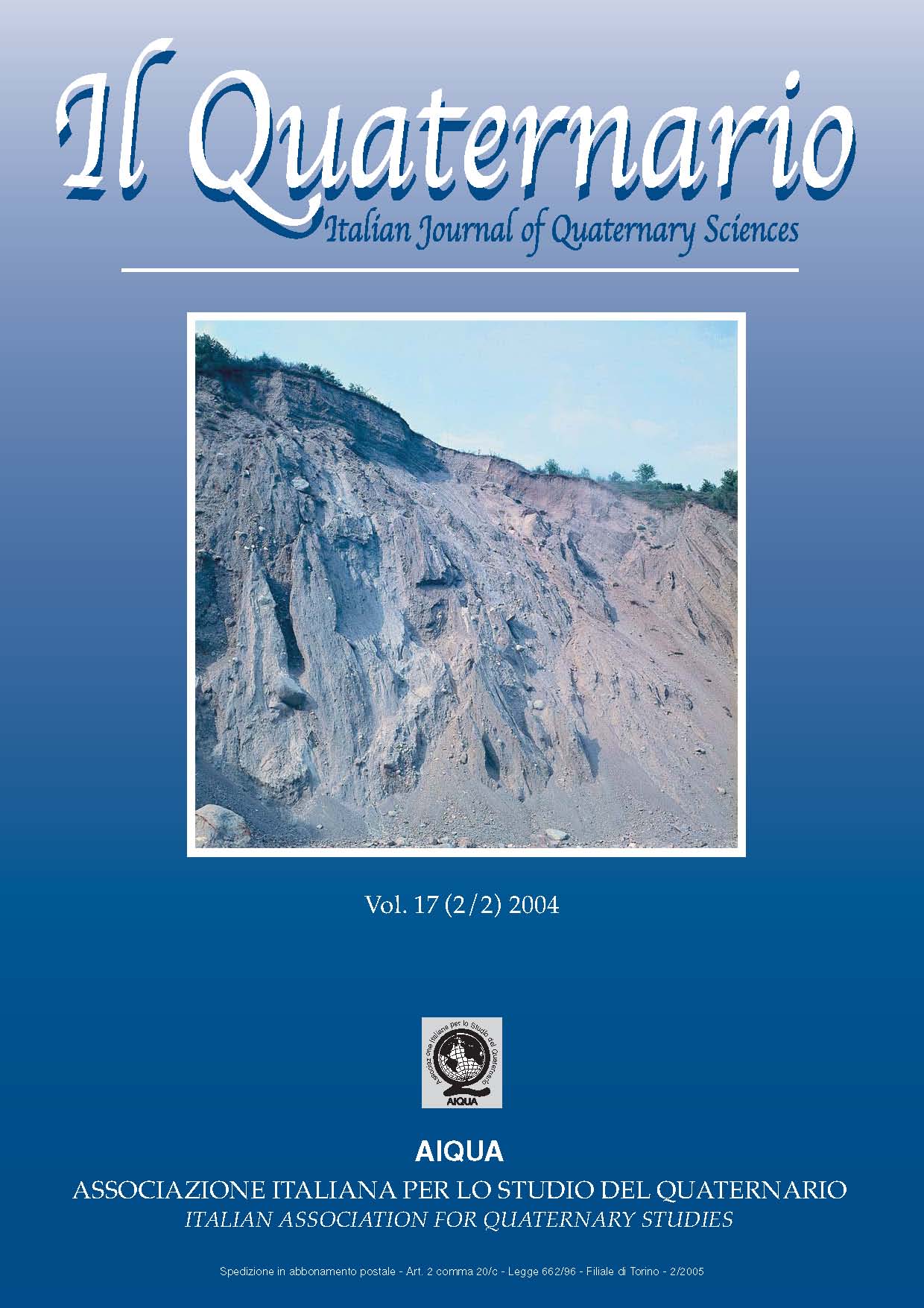EVOLUZIONE TARDO-OLOCENICA DEL DELTA DEL TEVERE
Main Article Content
Abstract
C. Giraudi, Late Holocene evolution of the Tiber delta IT ISSN 0394-3356, 2004
The Tiber delta has been studied using aerial photographs taken in three different flights in order to recognize geomorphological features, and with field surveys in the area of the ancient Stagno di Maccarese marshes.morphological studies have shown that there are groups of beach ridges forming eight homogeneous complexes that can be followed both in the northern and in the southern part of the delta. Dating of these beach ridges has proved possible thanks to the presence of buildings and artefacts on the ridges and through dating of the sediments in the depressions behind the ridges. The groups of outcropping beach ridges indicate eight phases of delta advance: the first phase is older than 3700-4000 years BC; the second one is older than 3275-2930 years BC; the third one is
dated about 3275-2930 years BC; the age of the fourth one is between 2140-1920 BC and 1300-1000 years BC; the fifth one is dated
about 910-800 years BC; the age of sixth one is between the 4th century BC and the 10th century AD; and the seventh and eighth phases are dated between the 15th and the 19th century AD.
Examination of the beach ridges has established that at least until the 9th century BC the mouth of the Tiber was situated where the
present Fiumicino channel runs. It was only between the 8th and the 4th century BC that the river became diverted to its present bed.
The delta has also undergone various retreat phases, which occurred between the sedimentation of the beach ridges of the first and
second phase (age greater than 3275-2930 years BC), between the fifth and the sixth phase (age between 8th and 1st century BC),
during the sixth phase (3rd century AD), and the morphologically most evident one, after the sixth phase ridges, dated from the Middle
Ages (10th-13th century).
Appreciable retreat of the coastline must also have taken place between 6000 and 2000 years ago due to the eustatic rise in sea level,
and parts – even extensive ones – of the groups of beach ridges must therefore have been eroded or overlain by more recent sediments.
The beach ridges formed during the significant advance of the delta that took place as from the 15th century occupy an area perhaps
even greater than that of all the earlier ridges. This fact does not imply that their development is exceptional: the most recent beach
ridges might be more extensive only because they have been entirely preserved.
It has been observed that in the area to the east of Focene the beach ridges have been broken up a number of times: the first time
after 3275-2930 years BC, the second time in a period after 910-800 years BC and before 7th century BC, and the third time probably
during the 1st century AD. In particular, the second break-up enabled salt water to flow into the Stagno di Maccarese freshwater marshes, which have existed at least since 5200-5300 BC.
In the Vignole area, traces of channels produced by the breaking of the natural banks of the Tiber have been found, as well as series of
crevasses, which may be dated at around the 9th and 10th century BC.
In the Maccarese and Le Pagliete area, the remains of two artificial canals of Roman age have been identified, suggesting, together
with artefacts found at Campo Salino, an attempt at the overall management of the lagoon in the northern area of the delta.
Comparing the evolution of the delta, the frequency of flood events in the Tiber at Rome, and the climatic phases recorded in the
Apennines (deduced from the variations in the Calderone glacier, in Lakes Fucino and Trasimeno level oscillations, and from the study
of Holocene alluvial deposits at Campo Imperatore), it has emerged clearly that the delta progradation phases are coaeval with the
cooler (advances of the Calderone glacier) and wetter (increase in level of the lakes) climatic phases, while the phases of coastal retreat
can be correlated with warmer periods characterized by the development of high mountain soils and the retreat of the Calderone glacier. The evolution of the delta, although affected by anthropic measures, appears to have been essentially conditioned by the climatic-environmental evolution of the Apennines.
Lastly, the hypothesis has been made that the asymmetric development of the beach ridges to the north and south of the area of the
Claudius and Trajan ports was due to a different degree of subsidence. However limited, in the course of time this subsidence has
influenced the evolution of the coastline: it probably favoured the formation of a discontinuity of the beach ridges in the area north of
the Fiumicino branch, helping to form a small inlet in which the port of Claudius was constructed.
Article Details
Section

This work is licensed under a Creative Commons Attribution-NonCommercial-NoDerivatives 4.0 International License.
The Author grants usage rights to others using an open license (Creative Commons or equivalent) allowing for immediate free access to the work and permitting any user to read, download, copy, distribute, print, search, or link to the full texts of articles, crawl them for indexing, pass them as data to software, or use them for any other lawful purpose.

